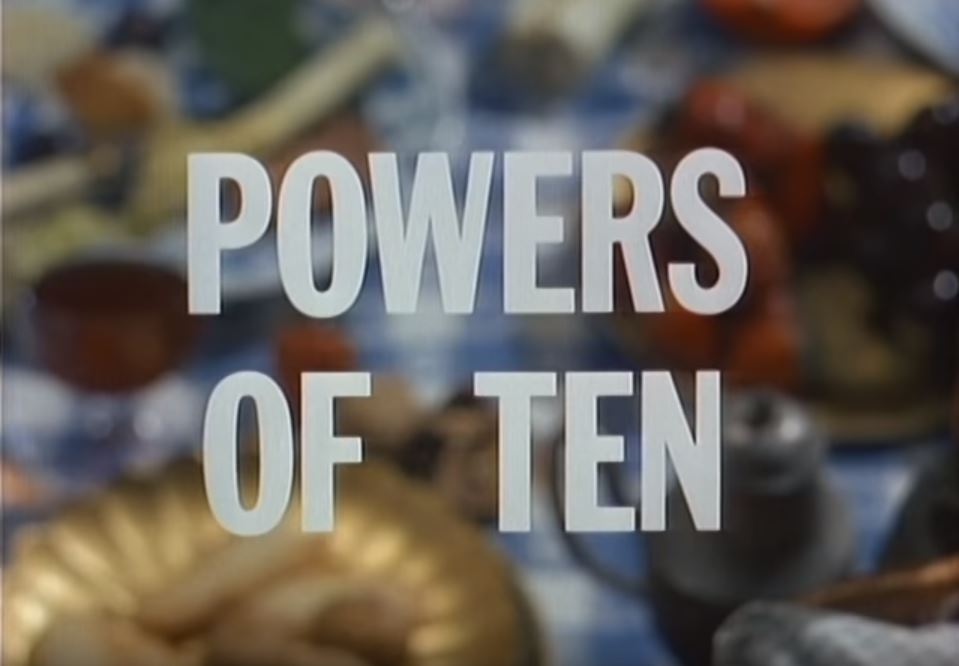Powers of Ten is one of several short films created by the great midcentury designers Ray and Charles Eames to explore how innovations in film could be employed to explain fundamental scientific concepts such as symmetry and biofeedback. Powers of Ten is by far the most well-known of these, and explains exponential change or, as its subtitle puts it, “the effect of adding another zero.” It was presumably the power of the Eameses’ gifts in linking the aesthetic to the conceptual, and the film’s further promise of visualizing “. . . the relative size of things in the universe,” that led to the installation of the Eameses’ 1968 version of Powers of Ten among the inaugural exhibits at the National Air and Space Museum in Washington, DC. It was on view from its opening day, July 4, 1976, until the end of 1979.

It was at the National Air and Space Museum that I first viewed this nine-minute film, along with thousands and thousands of American Gen-Xers. I expect that many readers of this forum will find the polished 1977 version familiar: its opening shot of picnickers in Chicago, its proto Google-Earth zoom above the Earth, its journey to the farthest reaches of outer space and then its dive into the blood cell of one of the picnickers, and finally into the subatomic realm of a carbon molecule. Listening to the cheery narrator describe how many million light-years we are away from Earth and seeing the buzzy artificial graphics of the carbon nucleus invariably provokes an unwanted wave of nostalgia for the progressive 1970s celebrations of human cultural and social difference mediated by the Children’s Television Workshop’s daily-dose reminder that “the Earth’s a big blue marble when you see it from out there.”
When we grow up we put away childish things. Or rather, we mature by discovering that things we thought were straightforward are actually more than they first appeared. So it could be said for Powers of Ten. The critical commentary on this film stakes out the ground. Critics have observed that Powers of Ten does a poor job visually depicting exponential change. Differences in scale would be more accurately represented by abrupt movements from one exponential plane to the next. In contrast, Powers of Ten keeps a continuous linear flow. The movement along a line, observe the critics, does less to displace the human scale than to maintain the human view no matter how far from the Earth she goes. The fact that the film’s space scenes depict sights that are hundreds of millions of light-years away from the Earth—and could never, in as many million years, be seen by a human (or any Earthly thing)—seems lost in the shuffle.
One can easily anticipate the following criticisms: Powers of Ten is not an innocent story of the power of adding an extra zero, but rather a fable that aestheticizes, celebrates, and universalizes an expansive postwar American-political-scientific empire. Powers of Ten is a secular guided meditation (or out-of-body experience) of empire. IBM was involved in the making of the film. Need we say more? The film, we might say, is not part of the solution and is indeed more likely to be part of the problem of late-capitalism, et cetera, et cetera.

Boeke’s book also explicitly promotes a humanistic message. It provides several pages of lesson plans and commentary explaining how scale can help people understand their modest place in the world. Its complex topic is not scale, but the even more pressing question of how the world’s creatures will continue to live rather than die together in a nuclear age. Boeke argued that for this, it was imperative for children and adults to learn to develop a sense of scale.
We all, children and grownups alike, are inclined to live in our own little world, in our immediate surroundings, or at any rate with our attention concentrated on those things with which we are directly in touch. We tend to forget how vast are the ranges of existing reality which our eyes cannot directly see, and our attitudes may become narrow and provincial. We need to develop a wider outlook.
The book is a plea and a tool for cultivating a humbler attitude, one that balances the nihilism that easily rushes in when one drifts to the scale of deep space with the implicit realization that we are all, each in our own bodies, the containers of multiple worlds. What appears implicit in the Eameses’ filmed version is made explicit in the final pages of the book:
Whereas at the end of our first journey [into the heavens] we stood in awe before the imposing greatness of the dimensions of the universe, and felt as nothing in comparison to their immensity, the conditions are not completely different. . . . Our own dimensions are now indescribably colossal compared with what we see. Thus on the scale of the last drawing, the height of the little girl would be about 15,000 million kilometers, more than the diameter of the solar system!
We are, that is, suspended in a universe of scales, responsible to some and responding to others.
Boeke’s quest was to make a better world by showing his students and readers that this is not all there is. To demonstrate that there are more ways of being, more interconnected powers in any “there” or “this” than any particular eye or mind, attuned to its own particular scale, can possibly comprehend. While writing this essay I often wondered: How much of this desire was shared by the Eameses in bringing this narrative to film? What did curators and directors of the National Air and Space Museum know about the film’s provenance?
I expect that the archives would reveal answers to these questions, but in the meantime, reading through Boeke’s book puts me in a mood to suspend the buffering melancholy of nostalgia, and the equally buffering melancholy of contemporary cultural criticism. And to observe, with the Eameses and Boeke, that our “this” is not even ours. We are all suspended in webs of indifference and dependency that are present with us, and in ways that are entirely incomprehensible to us.

https://www.flickr.com/photos/microagua/
On darker days, I fear that questions about the value of banding together and pleas for the utility thereof are losing their relevance altogether. And on those days it seems to me that the real audience for Powers of Ten is not the child of the 1970s but of the 2000s. Perhaps Boeke and the Eameses have unintentionally given us a gift, a short but powerful story that can help us prepare for the end of this world. A story that shows us that if we do not succeed, or if at this point it is already too late to succeed, in saving this world of ours, other worlds will certainly survive us. The atoms that make us up will not miss the Anthropocene. The galaxy will not sigh when our planet gives up its life. We will not be missed. This is not all there is.
And thanks god for that.












Thank you for this discussion. The powers of 10 has been an important book in my life. For decades, I have looked through it 2-3 times a year. It never fails to bring me a sense of peace and wonder, tho I fervently wish for an edition revised with updated technological achievements.